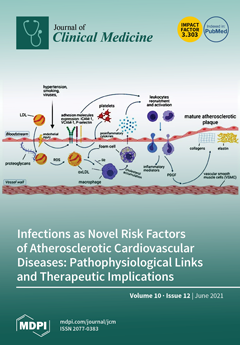Among patients with bronchiectasis, nontuberculous mycobacterial pulmonary disease (NTM-PD) ranged between 1 and 6% and it is suspected that its prevalence is underestimated. Our aim was to evaluate differences in computed tomography (CT) features in patients with bronchiectasis, with and without NTM-PD, in order to facilitate earlier diagnosis in the future. In addition, we evaluated longitudinal changes after successful NTM-PD treatment. One hundred and twenty-eight CTs performed in adults with bronchiectasis were scored for the involvement, type, and lobar distribution of bronchiectasis, bronchial dilatation, and bronchial wall thickening according to Reiff. In addition, associated findings, such as mucus plugging, tree-in-bud, consolidations, ground-glass opacities, interlobular thickening, intralobular lines, cavities, and atelectasis, were registered. Patients with NTM-PD (
n = 36), as defined by ATS/IDSA diagnostic criteria, were compared to bronchiectasis patients without NTM-PD (
n = 92). In twelve patients with an available consecutive CT scan after microbiological cure of NTM-PD imaging findings were also scored according to Kim and compared in the course. In patients with NTM-PD, there was a higher prevalence of bronchiectasis in the middle lobes (
p < 0.001), extended bronchiolitis (
p = 0.032) and more small and large nodules (
p < 0.001). Furthermore, cavities turned out to be larger (
p = 0.038), and walls thickened (
p = 0.019) and extended (
p = 0.016). Patients without NTM more often showed peripheral ground-glass opacities (0.003) and interstitial changes (
p = 0.001). CT findings decreased after successful NTM-PD treatment in the follow-up CT; however, without statistical significance for most features (
p = 0.056), but bronchiolitis was the only significantly reduced score item (
p = 0.043). CT patterns in patients with bronchiectasis and NTM-PD differ from those of patients with bronchiectasis without NTM-PD, although the findings are non-specific radiological features. Follow-up CT findings after microbiological cure differed interindividual regarding the decline in imaging features. Our findings may help practitioners to identify NTM-PD in patients with bronchiectasis. Further research is needed regarding the use of CT as a potential imaging biomarker for the evaluation of treatment response.
Full article






